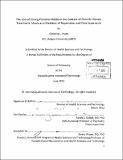| dc.contributor.advisor | Randy L. Gollub. | en_US |
| dc.contributor.author | Hsieh, Christine L. (Christine Lih) | en_US |
| dc.contributor.other | Harvard--MIT Program in Health Sciences and Technology. | en_US |
| dc.date.accessioned | 2014-01-14T15:25:34Z | |
| dc.date.available | 2014-01-14T15:25:34Z | |
| dc.date.issued | 2013 | en_US |
| dc.identifier.uri | http://hdl.handle.net/1721.1/83967 | |
| dc.description | Thesis (Ph. D.)--Harvard-MIT Program in Health Sciences and Technology, 2013. | en_US |
| dc.description | Cataloged from PDF version of thesis. | en_US |
| dc.description | Includes bibliographical references. | en_US |
| dc.description | Introduction: It is postulated that music has been part of society for at least 50,000 years, since the time that humans lived in one location of the world before dispersing across the globe (44). Over the eras it evolved in its manifestation, from classical performances enjoyed only by the elite, to soulful songs sung in the fields, to myriad forms of expression to be used by anyone. Today, its prominence has even evolved into being used as a tool for cognitive therapy, such as for aphasia patients (41), or to heal those who no longer have the ability to move their bodies (40). Given its incredible, seemingly endless potential, it is fruitful to explore new innovations in its usage - with treatment for chronic diseases such as depression, anxiety, and other mental disorders being ideal candidates. These diseases are high in their cost on resources, both human and monetary, and have weighty long-term impacts on patients' lives as well as their families', with depression being the leading cause of disability worldwide according to the World Health Organization (43). Music is positioned as a potent remedy, as its attributes are almost the mirror negative of the effects from chronic disease: it is low cost, pleasurably pervasive, and socially connecting Thus, the intention behind the design of study 1 in this thesis was to create a pilot, self -driven, wellness-enhancing music treatment that could be used as the basis for a future treatment for depression. It was meant to be a relatively brief longitudinal study examining adherence and feasibility for a personal music augmented mindfulness practice in a small group of healthy subjects. From the insights gleaned during this study, it was determined that the choice of strongly emotional, personal music could be potentially powerful in another disease context. In study 2, the design contracted from a longitudinal one to an acute, nuanced observation of enhanced music analgesia during experimental heat pain with healthy subjects. The clinical tool of interest was a proven analgesia boosting conditioning paradigm, which was combined in this study with personal music. Together, the two studies provide a revealing glimpse of humankind's ability to harness the best attributes it can for self-care from a medium it itself created. | en_US |
| dc.description.statementofresponsibility | by Christine L. Hsieh. | en_US |
| dc.format.extent | 80 pages | en_US |
| dc.language.iso | eng | en_US |
| dc.publisher | Massachusetts Institute of Technology | en_US |
| dc.rights | M.I.T. theses are protected by
copyright. They may be viewed from this source for any purpose, but
reproduction or distribution in any format is prohibited without written
permission. See provided URL for inquiries about permission. | en_US |
| dc.rights.uri | http://dspace.mit.edu/handle/1721.1/7582 | en_US |
| dc.subject | Harvard--MIT Program in Health Sciences and Technology. | en_US |
| dc.title | The use of strong personal media in the context of chronic disease treatment : music as a mediator of depression and pain experience | en_US |
| dc.type | Thesis | en_US |
| dc.description.degree | Ph.D. | en_US |
| dc.contributor.department | Harvard University--MIT Division of Health Sciences and Technology | |
| dc.identifier.oclc | 863154998 | en_US |
